NBA draft deep dive: Towns-Okafor in context, this year's sleepers and more
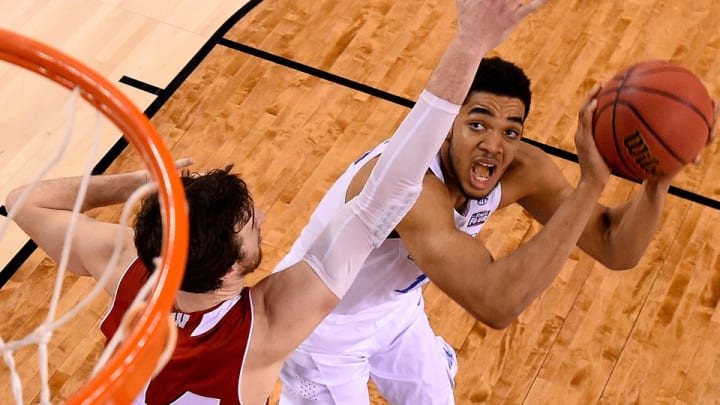
As rich as this draft is in talent, it's even deeper in big questions: The debate at No. 1 between freshmen big men Karl-Anthony Towns and Jahlil Okafor, the lack of clarity over who'll be the first wing (Justise Winslow or Stanley Johnson?) and first scoring guard (D'Angelo Russell or Emmanuel Mudiay?) taken, the arguments over the pro value of unique veterans Frank Kaminsky and Willie Cauley-Stein, and the undefined pecking order of the second tier of point guards that includes Cameron Payne, Tyus Jones, Jerian Grant, Delon Wright and Andrew Harrison. I don't have all the answers, but I've spent the past seven months covering these prospects and analyzing their advanced statistics, and this is (the bulk of) what I know:
1. Karl-Anthony Towns' defense tends to get discussed in the context of Jahlil Okafor's defense. As in: Towns' defensive value was superior to Okafor's in college, and is likely to be superior to Okafor's in the NBA. I agree with this—it might be the most widely agreed-upon thing in the draft—but also think it short-changes Towns. By at least one metric, his defensive contributions were greater than any other college player over the past five seasons.
Basketball-Reference.com developed an all-encompassing stat called Win Shares; while the formula is complicated, it's essentially a hybrid of Dean Oliver's Offensive and Defensive ratings and Bill James' baseball concept of assessing individual credit for team success. BR has comprehensive college win-share data going back to '09-10, and if one takes strictly the defensive portion of the formula and applies it on a per-40 minute basis, the top 10 includes current all-NBA defender Draymond Green at No. 10, for his work at Michigan State in 2011-12, freak of nature Anthony Davis at No. 3, for his incredible D on Kentucky's 2012 national-title team … and Towns at No. 1.
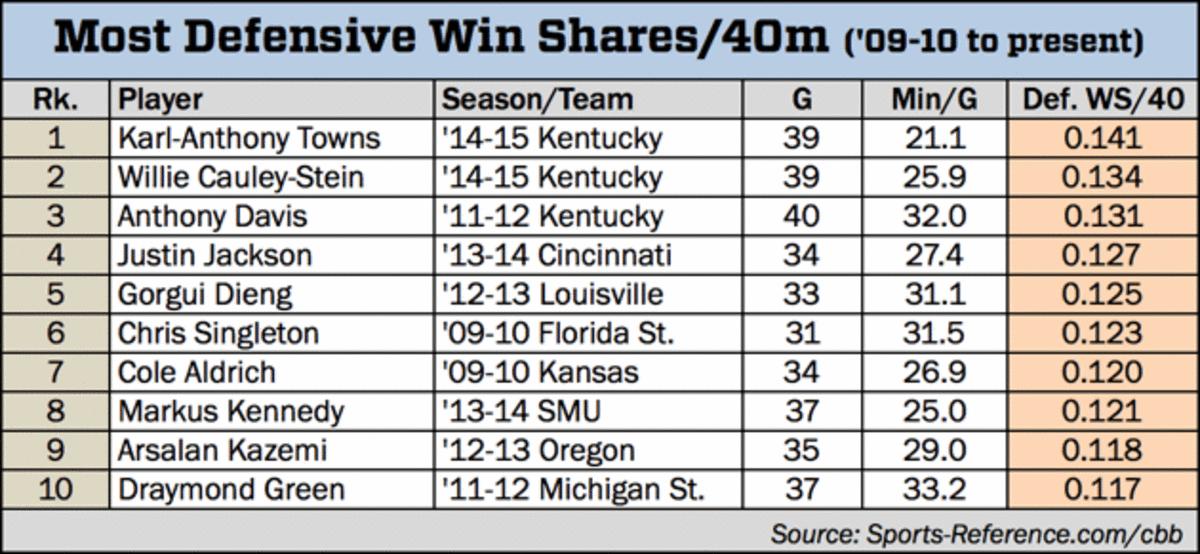
Win Shares, like all other attempts at all-encompassing stats, has its flaws and blind spots. Defensively, it uses an Oliver rating that’s based on box-score stats (defensive boards, blocks and steals), which never tell the full story, and heavily favors big men who are on great overall defensive teams. So Towns's value could very well be overstated here, due to the fact that he excels at box-score defensive stats and struggles in less-measurable areas (leaving his feet and fouling, getting caught flat-footed on pick-and-rolls, being physical, etc.), and that he played alongside some excellent defenders at Kentucky. Expecting him to be a better NBA defender than Green or Davis would be unwise. But it's not a stretch to call Towns a key component of one of college basketball's greatest modern-era defenses and one of the top 2-3 defensive prospects in the entire draft—both of which are more appropriate labels than simply being called Better Than Okafor.
2. Willie Cauley-Stein might still be underrated. That Kentucky's Cauley-Stein, the man whose middle name is now officially "Trill", is No. 2 in that DWS/40 chart despite his best qualities falling outside traditional box scores is remarkable. The rangy 7-footer gets his share of rebounds, blocks and steals, but when I charted the Wildcats' defense for an SI magazine project this season, Cauley-Stein's real value became evident in rim protection (he was Kentucky's best at this); overall turnovers forced (also best on the team on a per-possession basis); switchability on pick-and-rolls, handoffs and off-ball screens; and his ability to act as a sort of rover who could, on any given possession, guard men on the blocks, cut off penetration, or close out on perimeter shooters. It's these hard-to-track and less-quantifiable attributes that make Cauley-Stein a justifiable top-five pick with the potential for a long, valuable NBA career.
3. The Towns-Okafor debate isn't splitting hairs. Everyone is also well aware that Towns is the superior free-throw shooter. Towns' accuracy was remarkable—he was 30-of-34 (88.2%!) from the stripe in the postseason—and Okafor's struggles were his only major offensive flaw. But it wasn't until I placed their work in context of elite frontcourt prospects of the past that the level of disparity became clear.
• MORE NBA: Mock Draft 2.0 | Jahlil Okafor Q&A | NBA playoff coverage
In the past 30 drafts (1985-2014), 12 players 6'11" or taller have gone Nos. 1 or 2 overall, as Towns and Okafor are projected to go in June. I used DraftExpress' database to compare the free-throw shooting stats of such players from their age-19 college seasons*, and Towns' 81.3% was better than anyone in that group … and Okafor's 51.0% was worse than anyone in that group.
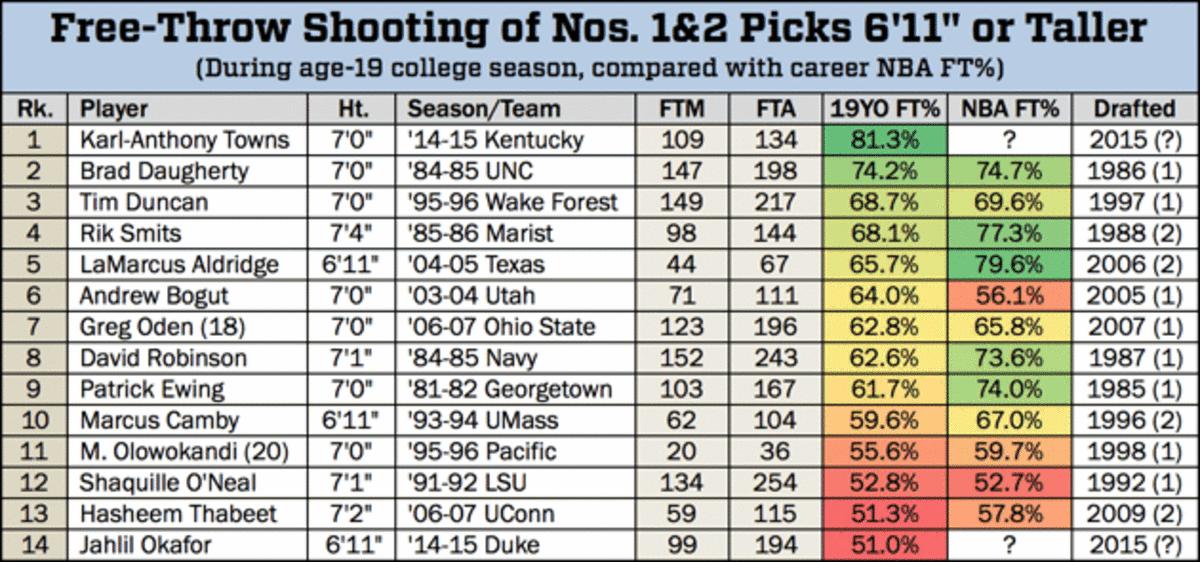
So, in the Towns-Okafor debate, you're not just looking at one big man who shoots well from the stripe and one who struggles. You're looking at potentially the best and worst free-throw shooters of any franchise-center prospects over the past three decades. That Okafor even remains in the conversation for No. 1 is a testament to just how good he is as a low-post scorer and passer—arguably the most advanced freshman post player in the entire modern era of college basketball.
(* Oden's 18-year-old season is used here because he turned pro afterwards; Olowokandi's 20-year-old season is used because he was that old as a freshman.)
4. We didn't see the full version of Towns at Kentucky. It is a pre-draft rite of passage for big men who didn't shoot many jumpers in college to claim to have that skill in their arsenal—that it was merely under-showcased. Most of the time this is nonsense, an agent's ploy to boost draft stock. But in the case of Towns, who attempted just eight treys as a Kentucky freshman, there's reason to believe he could eventually become Stretch-Towns in the NBA, and not just because of his pure stroke from the free-throw line.
During the NCAA tournament, I was interviewing Dave Turco, Towns' high-school coach from St. Joseph's (Metuchen, N.J.), and brought up the topic of his limited three-point opportunities as a Wildcat. That Towns had attempted just eight, Turco said, "Is insane, because I'm telling you, that's his best shot. He can knock down threes."
• MORE NBA: Roundtable: Is Okafor or Towns the better prospect?
And Towns is not just a practice shooter: In three years at St. Joseph's, Towns made 127 treys, and his senior season, he shot 51.6% from deep. When he played for the Dominican Republic's U17 team in 2011, he shot 45.5% (10-of-22) on FIBA-length threes. And there were occasional glimpses of this in Lexington, like this fluid, corner catch-and-shoot against Eastern Kentucky in December:
Kentucky big men under John Calipari are not typically green-lit to take threes, and Calipari felt that Towns, even with his past as a shooter, was more valuable to the Wildcats playing near the rim. Towns' development as an interior force at Kentucky is what put him in the No. 1-pick conversation, so that strategy didn't hurt his stock one bit, but it does seem probable that he can take on an expanded offensive role.
5. Finding an NBA comparison for Frank Kaminsky isn't easy. Wisconsin 7-footer Frank Kaminsky doesn't need to convince anyone he can shoot. There's ample evidence of the winner of the Naismith and Wooden awards hitting threes, so much so that the NBA player he's been most frequently compared with in the lead-up to the draft is Magic stretch-four Channing Frye. Being compared to Frye isn’t insulting, as he's one of the best long-range bigs in the league, but it short-changes Kaminsky's offense. When evaluating "Frank The Tank" as a prospect it's important to remember that he was super-effective from beyond the arc and in the paint, and in the latter portion of his senior season, he was dominating with off-the-dribble basket attacks and interior moves far more than he was with long-range shots.
The Kaminsky-Frye comparison doesn't hold up when you place their '14-15 shot charts (via ShotAnalytics.com) side-by-side, because one is that of a multi-dimensional scorer, the other is one-note. Kaminsky's formula of paint points + top-of-arc/wing threes + midrange avoidance gives him a shot chart that looks more like a rich man's Kelly Olynyk or Draymond Green than it does a facsimile of Frye:
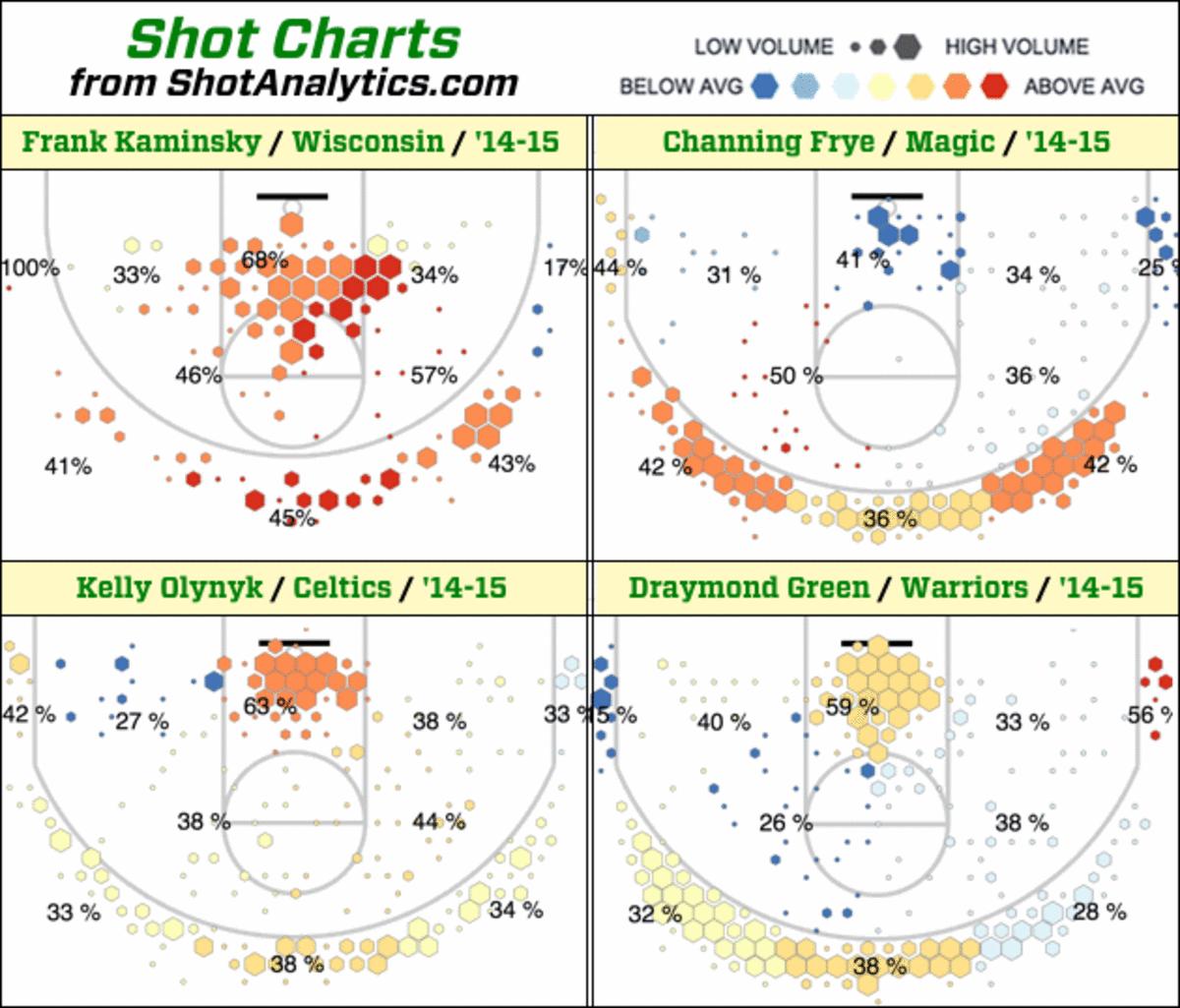
6. Feel free to call Kaminsky the most efficient shooting and posting big man in the draft. His 1.051 PPP on post-ups this season was the best of any potential draftee with at least 100 post-up possessions in Synergy Sports Technology's database—and well ahead of Okafor and Towns:
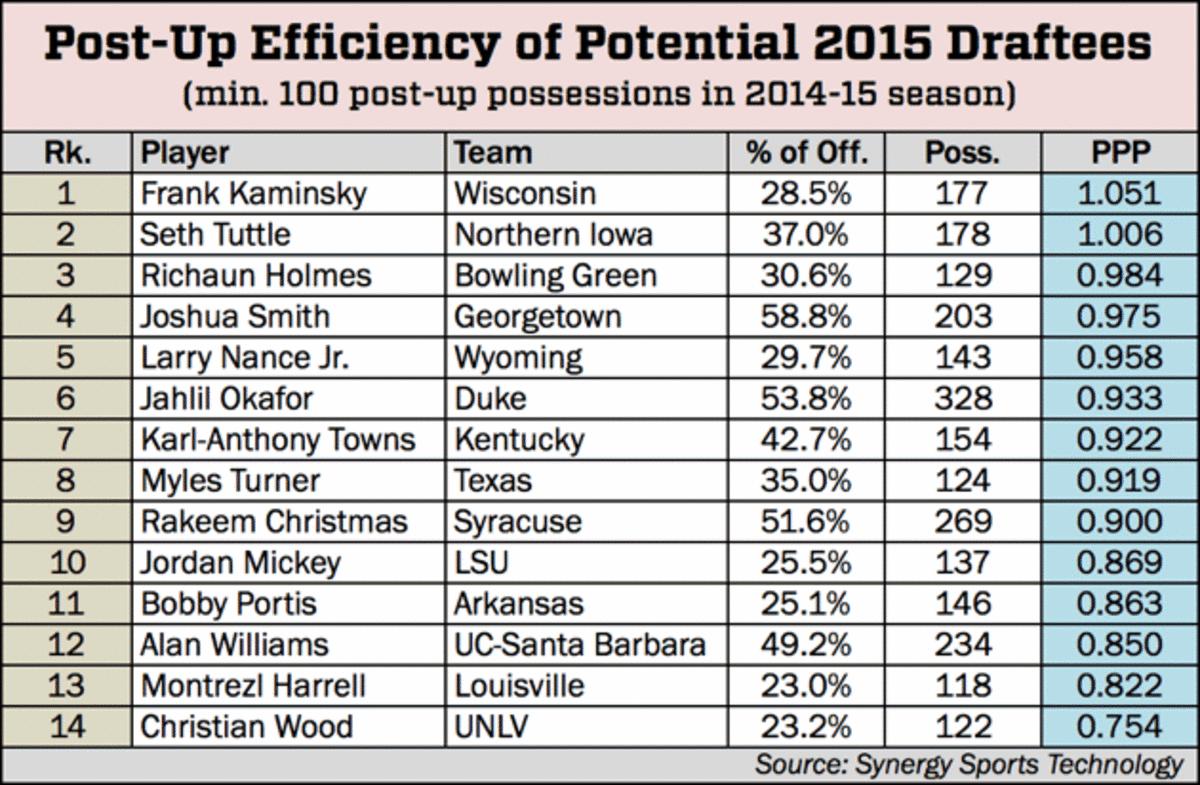
I still regard Okafor as this draft's best long-range prospect in the post. What he accomplished at his age and at that volume—posting up 8.4 times per game compared to Kaminsky's 4.7, with reasonable efficiency—leads me to believe that Jah will be a low-block monster in the NBA. But that's not the point of this chart. The point is to offer further proof that Kaminsky's value goes well beyond shooting. And the point of the next chart is to show that his value also extends into …
7. ... the most under-appreciated part of Kaminsky's game: Playmaking. As Grantland's Zach Lowe wrote this week, defensive evolutions in the NBA are making "playmaking fours"—guys who can spot-up shoot but also make things happen off the bounce—more in-demand. Which bodes well for Frank, because it's exactly what he did this season at Wisconsin.
Among the power forwards and centers likely to be drafted in 2015, Kaminsky had the most assists per 40 minutes, pace-adjusted, and he was the only big man with a positive Pure Point Rating—a John Hollinger-developed stat that assesses playmaking with this formula: 100 x (National Pace/Team Pace) x ([(Assists x 2/3)-Turnovers] / Minutes).
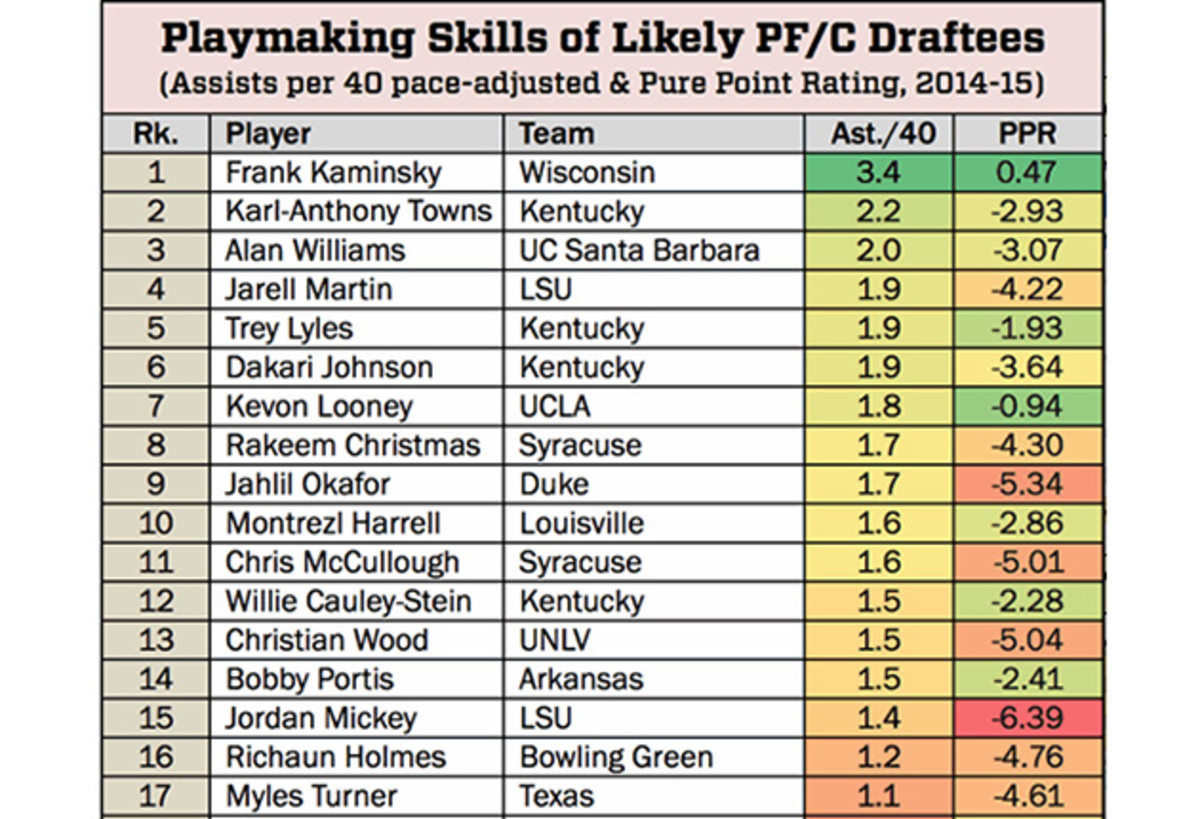
How rare is it for an elite big man to come out of college with a positive Pure Point Rating? Well, in the past 10 drafts, there's only been one first-round pick 6'10" or taller with a PPR better than negative-1: Kentucky's Anthony Davis (-0.59 in '11-12), who's on a trajectory to win an MVP in the next 2-3 years. And there's been just one draftee 6'10" or taller with a better college PPR than Kaminsky's +0.47: Florida's Chandler Parsons (+0.82 in '10-11), who was a second-round steal by the Rockets and functions as a small forward.
8.Don't sleep on Delon Wright. A weakness of college hoops writers, who moonlight as draft analysts, is that we tend to get too bullish on seniors, so take this with that in mind: I'm bullish on Utah's Delon Wright as this draft's late-first/early-second round sleeper. A 6'5" point guard, Wright passes the eye test as a savvy playmaker and long-armed, steal-generating defender (he got the nickname "Sticky" from his old AAU coach for always getting his hands on the ball), and he excels in key statistical categories.
Assists, rebounds and blocks per 40 minutes are some of the college stats with the strongest correlations to the NBA, and college steals per 40 are viewed as a success indicator. This past season, Wright averaged 6.2 assists, 6.2 rebounds, 1.2 blocks and 2.6 steals per 40 minutes, pace-adjusted. In the past 15 seasons of college hoops, there were only five other players—overall, not just among draft prospects—who averaged at least 5.0 assists, 5.0 rebounds, 1.0 blocks and 2.5 steals:

An MVP, Linsanity, a 10-year veteran, a Rookie of the Year and a guy who at least briefly played well for OKC: This is good company for Wright to keep. He was arguably a better college player than everyone on that list except Dwyane Wade, has held his own in Drew League and pickup games with his older brother Dorell's NBA friends for years, and should be able to contribute in a bench role immediately as a pro. Scouts have concerns over Wright's long-range shooting ability, due to his general reluctance to take threes, and the fact that he made just 22.6% of them as a junior, but I think it's a bit overblown. He shot 35.6% from deep as a senior and 83.5% from the free-throw line, which is relevant because it tends to correlate to distance-shooting success in the NBA.
Cavaliers' LeBron James, David Blatt reflect on season after making Finals
9. My deeper sleeper is a 3-and-D candidate. Deep as in, someone who doesn't even appear in the first or second round of major mock drafts. My mystery man is Villanova's Darrun Hilliard, a 6'6" wing who shot 39.9% from long range over the past two seasons. He can make plays off the bounce without committing turnovers and he's an athletic, smart perimeter defender who can guard point guards and wings.
Hilliard earned some All-America votes during Villanova's 33-3 run this season, so he isn't anonymous, but his true impact on the Wildcats' back-to-back Big East title teams has been under-acknowledged. In '13-14, according to HoopLens.com's plus-minus data, the Wildcats had an efficiency margin of +0.201 points per possession when Hilliard was on the floor—the highest margin of anyone in their rotation. And in '14-15, Villanova was an amazing +0.273 PPP with Hilliard on the floor—again the highest margin of anyone in its rotation. He had massive, positive impact on 'Nova's offense and D, and was quietly one of the nation's most valuable players. He's worth a late-second-round pick.
10. The biggest value pick of all, though, could be Duke small forward Justise Winslow if he drops into the 7-9 range. It's rare to land someone at that slot who has a chance to be the best player in the draft, and if you watched Winslow this postseason, when he often looked more like a first-team All-American than The Third-Most Famous Duke Freshman, you know what he's capable of when fully healthy. His package of shooting, finishing, rebounding and defense rates well analytically, and his explosive-yet-graceful basket attacks and ability to maneuver in traffic passes the eye test.
I prefer Winslow in most regards over Arizona freshman Stanley Johnson, who's his prime competition to be the first wing off the board, and also think Winslow played far better against high-level competition than did Ohio State freshman D'Angelo Russell, who's likely to be the first perimeter player taken overall. Russell is a promising guard to land at Nos. 3-4; Winslow is a steal at anywhere from the seventh pick and beyond.
